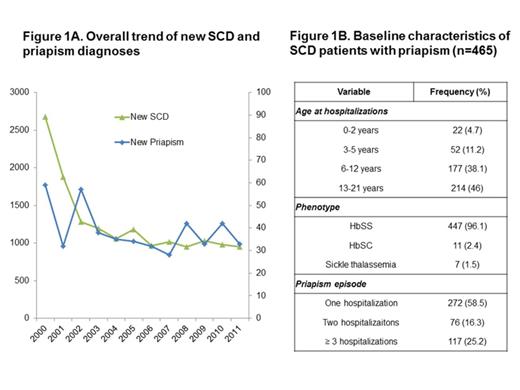Abstract
Priapism is a known but largely understudied complication of sickle cell disease (SCD). The epidemiology of priapism in children and adolescents with SCD is not well characterized especially the pattern of hospitalization. Data are scarce about the role of blood transfusion and surgical therapies in the management of priapism in SCD. Recent expert opinion questions the efficacy of blood transfusion and recommends early urological interventions in these patients (Merritt et al. Can J Emerg Med 2006, Kato GJ. J Sex Med. 2012). As hospitalization consumes lots of economic resources, we studied the trend and outcome of hospitalization for priapism in children with SCD over the last decade.
We used the Pediatric Health Information System (PHIS), an electronic database of children's hospitals in the US. Patients ≤ 21 years of age with SCD from 33 hospitals from 2000-2011 were analyzed. SCD, priapism and all related conditions were identified by ICD-9 codes. We examined patient demographics, timing of hospitalizations, treatment details, RBC transfusion (simple and exchange transfusion), and urologic procedures (including aspiration and irrigation of corpus cavernosum, corpora cavernosa-corpus spongiosum shunt and corpora-saphenous shunt) and hospital charges. With the inherent skewness of the length of stay and cost data, we used non-parametric analysis when comparing summary statistics. Given the level of over-dispersion, a negative binomial model was used to determine adjusted length of stay and cost. A p-value <.05 was considered statistically significant.
From 2000 to 2011, there were 7929 unique male pediatric patients with SCD identified. Among these 465 (5.9%) patients had a diagnosis of priapism and accounted for 1069 priapism related hospitalizations. Overall, the number of new sickle cell patients with priapism getting hospitalized remained stable (Figure 1A). The demographic and baseline characteristics of these patients are shown in Figure 1B. In 63% (673/1069) of the priapism related hospitalizations, patients received conservative treatment whereas blood transfusion, urologic procedures or both were performed in 25.2% (269/1069), 6.6% (71/1069) and 5.2% (56/1069) of the hospitalizations respectively. Five percent (51/1069) of priapism related hospitalizations required ICU care, 1% (15/1069) required mechanical ventilation and there was no in-hospital mortality. Average length of stay for priapism related hospitalization was 3.8 days. Multivariate regression analysis showed that the presence of VOC, ACS, blood transfusion, and urologic procedures were independently associated with increased length of stay and costs (Table 1). Multivariate analysis showed neither transfusion nor urologic procedures were associated with neurological complications observed during priapism related hospitalizations.
Predictors of length of stay and hospital costs in priapism related hospitalizations
| Variable . | Length of Stay (LOS) . | Total Hospital Cost . | ||||||
|---|---|---|---|---|---|---|---|---|
| Coefficient . | Std. Error . | p-value . | Adjusted LOS (days) . | Coefficient . | Std. Error . | p-value . | Adjusted Cost (in $1000 dollars) . | |
| ACS | 0.403 | 0.101 | <.0001 | 5.84 | 0.664 | 0.130 | <.0001 | 17.25 |
| VOC | 0.379 | 0.060 | <.0001 | 5.77 | 0.253 | 0.101 | 0.012 | 14.04 |
| No Transfusion/Procedure | reference | -- | -- | 3.57 | reference | -- | -- | 8.04 |
| Transfusion-only | 0.334 | 0.069 | <.0001 | 4.99 | 0.474 | 0.107 | <.0001 | 12.91 |
| Procedure-only | 0.257 | 0.098 | 0.009 | 4.61 | 0.357 | 0.111 | 0.0013 | 11.49 |
| Both Transfusion/Procedure | 0.573 | 0.106 | <.0001 | 6.33 | 0.895 | 0.141 | <.0001 | 19.67 |
| Variable . | Length of Stay (LOS) . | Total Hospital Cost . | ||||||
|---|---|---|---|---|---|---|---|---|
| Coefficient . | Std. Error . | p-value . | Adjusted LOS (days) . | Coefficient . | Std. Error . | p-value . | Adjusted Cost (in $1000 dollars) . | |
| ACS | 0.403 | 0.101 | <.0001 | 5.84 | 0.664 | 0.130 | <.0001 | 17.25 |
| VOC | 0.379 | 0.060 | <.0001 | 5.77 | 0.253 | 0.101 | 0.012 | 14.04 |
| No Transfusion/Procedure | reference | -- | -- | 3.57 | reference | -- | -- | 8.04 |
| Transfusion-only | 0.334 | 0.069 | <.0001 | 4.99 | 0.474 | 0.107 | <.0001 | 12.91 |
| Procedure-only | 0.257 | 0.098 | 0.009 | 4.61 | 0.357 | 0.111 | 0.0013 | 11.49 |
| Both Transfusion/Procedure | 0.573 | 0.106 | <.0001 | 6.33 | 0.895 | 0.141 | <.0001 | 19.67 |
In our largest pediatric in-patient sickle cell cohort, the prevalence of priapism was 5.9%. New inpatient diagnoses of priapism among children with SCD remained constant overtime as previously reported in adult SCD population (Chrouser et al. Am J Surg 2011). Majority of our patients received conservative treatment and urologic procedures were utilized infrequently, again consistent with adult literature. Both blood transfusion and urologic procedures were associated with increased length of stay and costs but not with neurological complications. There is a strong need for prospective, multi-institutional trials to define the role of blood transfusions, surgical procedures and other novel therapies to improve the outcome.
No relevant conflicts of interest to declare.
Author notes
Asterisk with author names denotes non-ASH members.


